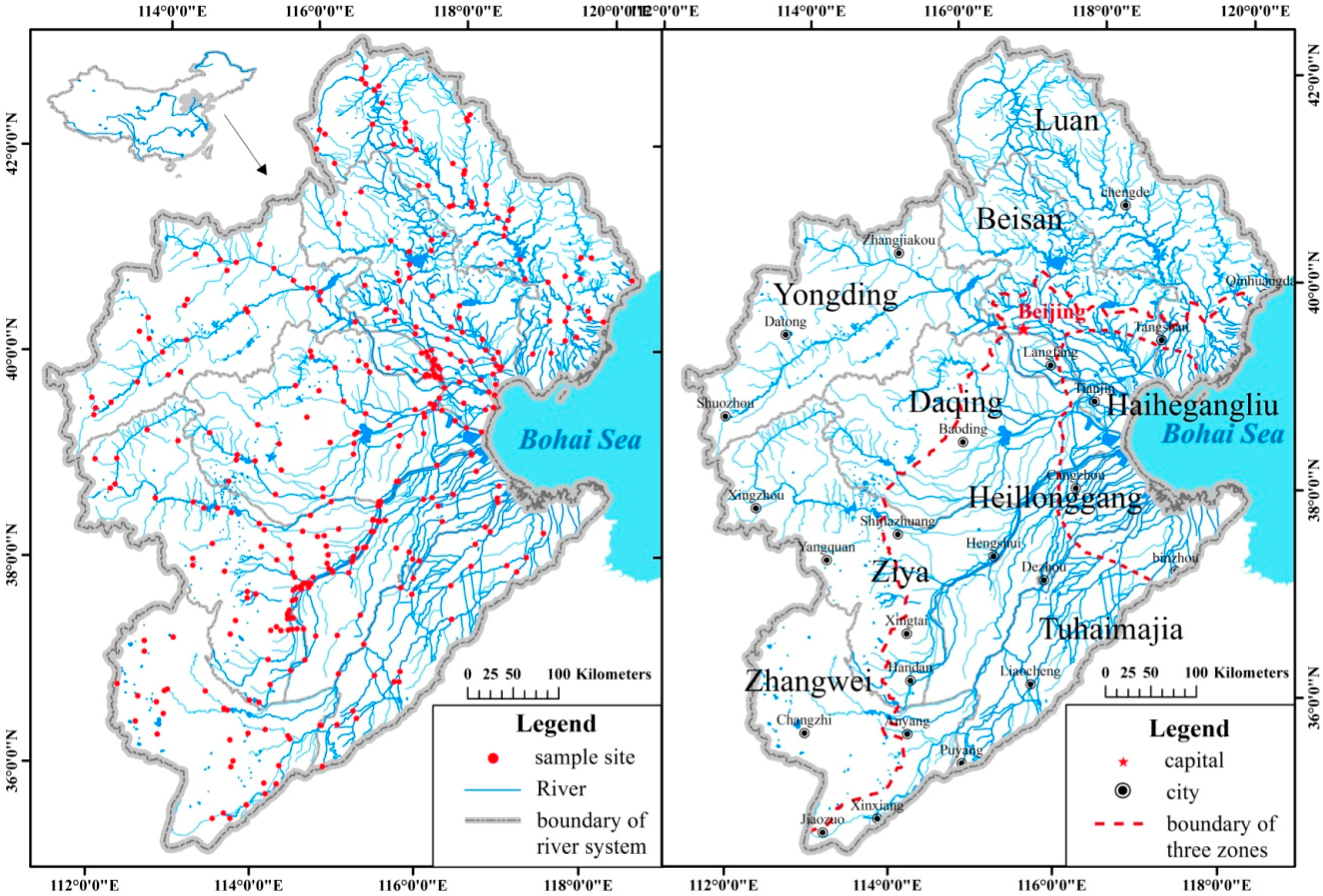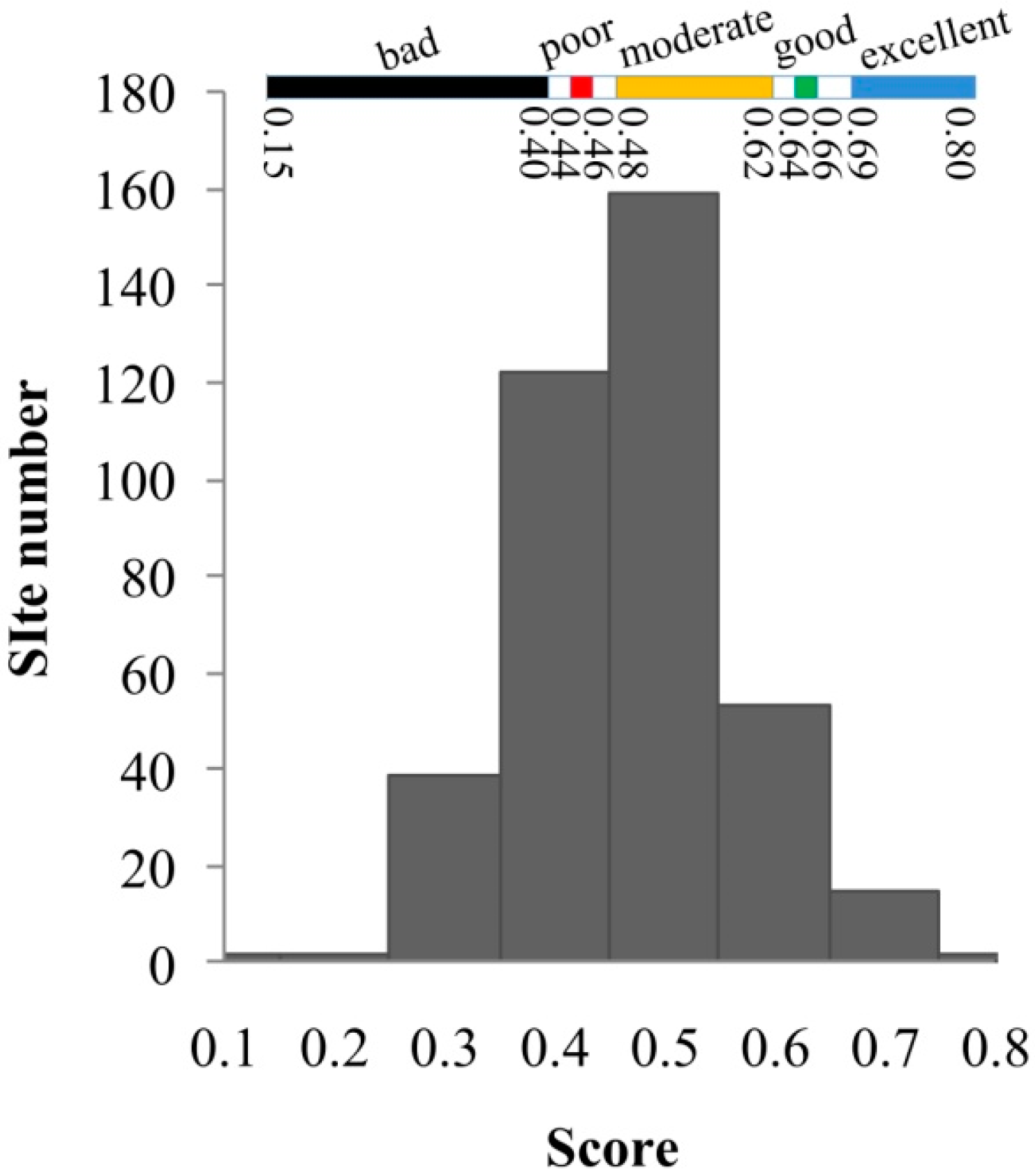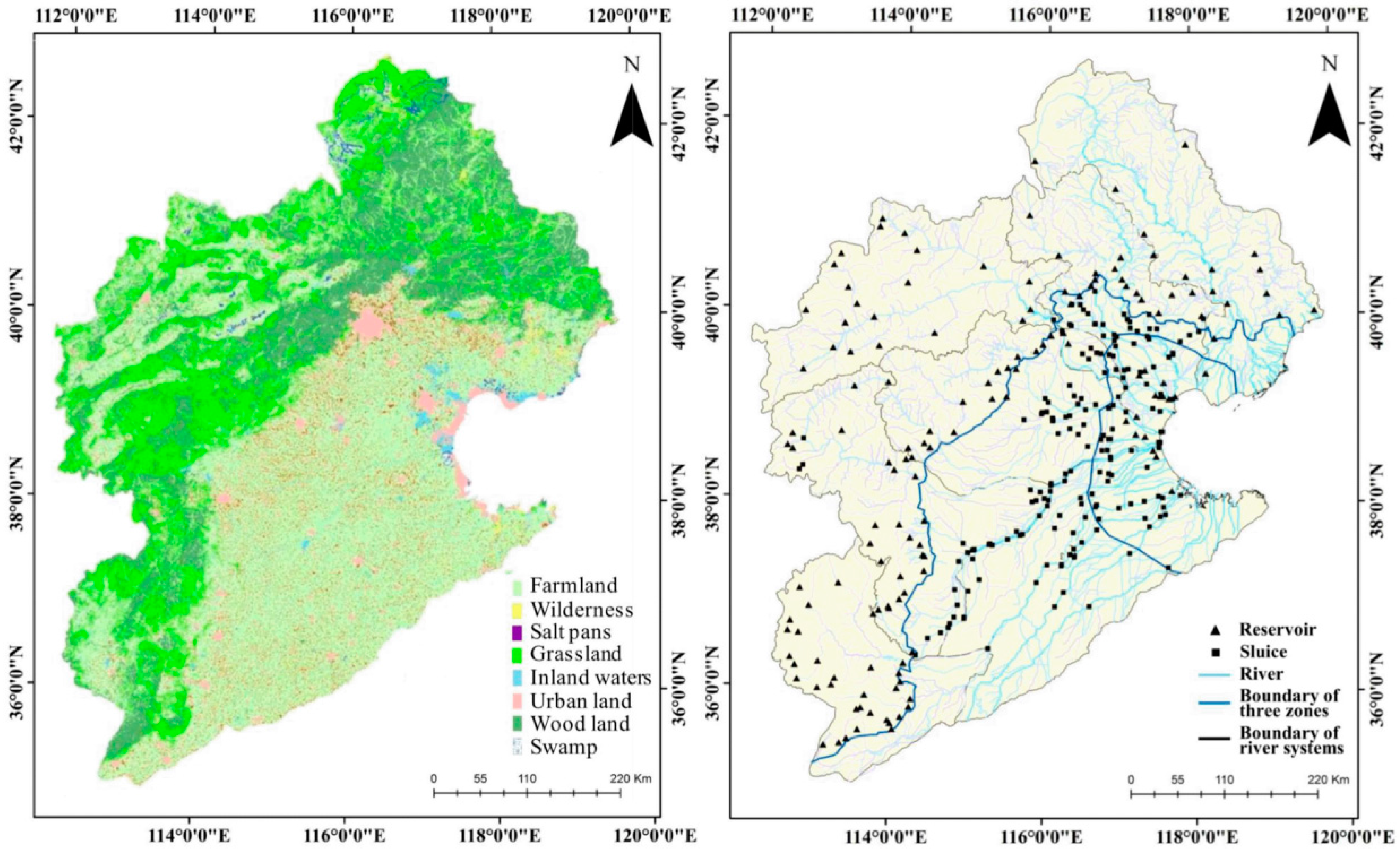Assessment of River Habitat Quality in the Hai River Basin, Northern China
Abstract
:1. Introduction
2. Methods
2.1. Study Area and Sampling Sites

2.2. Indicators and Field Survey
2.2.1. Indicators Selection
2.2.2. Scoring and Assessment
Low Pressure
Habitat Diversity
Continuity of Vegetation
Stability and Cleanliness of the Channel
2.2.3. Field Survey
Width of Riparian Zone
Land Use Pattern
Coverage of Riparian Vegetation
Continuity of Riparian Vegetation
Bank Modification
Channel Structure
Channel Substrate
Channel Pattern
Hydrophyte Richness
Coverage of Emergent Plants
2.2.4. Data Analysis
3. Results and Discussion
3.1. River Habitat Quality


| River system | Excellent | Good | Moderate | Poor | Bad |
|---|---|---|---|---|---|
| Luan | 21.43% | 30.36% | 28.57% | 17.86% | 1.79% |
| Ziya | 2.79% | 6.51% | 37.21% | 28.37% | 25.12% |
| Tuhaimajia | 0.00% | 23.81% | 23.81% | 38.10% | 14.29% |
| Daqing | 0.00% | 16.22% | 29.73% | 21.62% | 32.43% |
| Beisan | 2.56% | 23.07% | 41.02% | 21.79% | 11.54% |
| Yongding | 9.37% | 18.75% | 28.13% | 28.13% | 15.63% |
| Zhangwei | 8.11% | 16.22% | 43.24% | 24.32% | 9.11% |
| Heilonggang | 0.00% | 12.90% | 25.81% | 45.16% | 16.13% |
| Total basin | 5.64% | 17.40% | 34.56% | 26.72% | 15.69% |
| Zones | Excellent | Good | Moderate | Poor | Bad |
|---|---|---|---|---|---|
| Upper mountain area | 15.86% | 28.97% | 32.41% | 16.55% | 6.21% |
| Middle plain area | 0.00% | 8.70% | 37.89% | 32.92% | 20.49% |
| Littoral area | 0.00% | 15.71% | 38.57% | 30.00% | 15.71% |
3.2. Differential Representation of the RHQ in the Three Zones
| Upper Mountain Area | Middle Plain Area | Littoral Area | |
|---|---|---|---|
| Width of riparian zone | 14.50–30.00 m | 0.00–30.00 m. 75% of “poor”&“bad” sites with primary score ≤ 2 | 2.50–30.00m. 66% of “poor”&“bad” sites with primary score ≤ 2 |
| Land-use pattern | Mainly near-natural vegetation | Mainly farmland and public land. 63% of “poor”&“bad” sites with primary score ≤ 2 | Mainly public land and industrial land. 69% of “poor”&“bad” sites with primary score ≤ 2 |
| Coverage of riparian vegetation | 23%–81% | 2%–55%. 82% of “poor”&“bad” sites with primary score ≤ 2 | 1%–30%. 86% of “poor”&“bad” sites with primary score ≤ 2 |
| Continuity of riparian vegetation | Continuous/semi-continuous patches | Continuous/semi-continuous rows and small patches, discontinuous small patch, scattered and isolated | Semi-continuous rows and small patches, scattered and isolated |
| Bank modification | Rarely farming on bank; volume of solid waste was 1–5 m3 | Commonly farming on bank; volume of solid waste was 1–120 m3. 58% of “poor”&“bad” sites with primary score ≤ 2 | Rare farming on bank; volume of solid waste was 1–110 m3. 56% of “poor”&“bad” sites with primary score ≤ 2 |
| Width/depth ratio | 2.58–217.00 | 3.12–150.00 | 6.18–56.67 |
| Channel substrate | Mainly boulder, cobble, pebble gravel; rarely bedrock, sand, silt and clay | Mainly silt and clay and hewn stones; rarely sand, and gravel | Mainly sand, silt and clay. 87% of “poor”&“bad” sites with primary score ≤ 2 |
| Channel pattern | Distributary, braided and single flow channel. 77% of “poor”&“bad” sites with primary score ≤ 2 | Mainly single flow channel, rarely distributary and hardened channel. 67% of “poor”&“bad” sites with primary score ≤ 2 | Mainly single flow channel, rarely distributary channel. 81% of “poor”&“bad” sites with primary score ≤ 2 |
| Hydrophyte richness | Emergent plant, submerged plant, algae and moss. 87% of “poor”&“bad” sites with primary score ≤ 2 | Mainly emergent plant, submerged plant, floating plant; rarely algae and moss. 62% of “poor”&“bad” sites with primary score ≤ 2 | Mainly emergent plant, submerged plant. 83% of “poor”&“bad” sites with primary score ≤ 2 |
| Coverage of emergent plants | 3%–72% | 1%–90%. 69% of “poor”&“bad” sites with primary score ≤ 2 | 0%–78%. 78% of “poor”&“bad” sites with primary score ≤ 2 |

3.3. Discussion on Controlling Factors of RHQ

| Woodland | Grassland | Farm Land | Construction Land | Urban Land | GDP | Population | |
|---|---|---|---|---|---|---|---|
| Excellent | 1.000 ** | 1.000 ** | −0.985 | −0.807 | −0.962 | −0.474 | −0.413 |
| good | −0.936 | −0.941 | −0.985 | −0.558 | −0.997 * | −0.746 | −0.698 |
| moderate | −0.996 | −0.995 | 0.963 | 0.862 | 0.930 | 0.383 | 0.319 |
| poor | −0.984 | −0.986 | 1.000 ** | 0.697 | 0.994 | 0.615 | 0.559 |
| bad | −0.940 | −0.945 | 0.987 | 0.568 | 0.998 * | 0.738 | 0.689 |
| River System | Quantity of Dams and Sluices | Length of River Network (km) | Index of Connectivity |
|---|---|---|---|
| Luan | 449 | 1653.50 | 3.68 |
| Beisan | 257 | 967.20 | 3.76 |
| Yongding | 589 | 1223.60 | 2.08 |
| Daqing | 172 | 430.50 | 2.50 |
| Ziya | 438 | 1622.80 | 3.70 |
4. Conclusions
Acknowledgments
Author Contributions
Conflicts of Interest
Appendix
| Site Number | River Name | Location | Catchment | |||||||||||
|---|---|---|---|---|---|---|---|---|---|---|---|---|---|---|
| Date & Time | Surveyor Name | Weather Conditions | Flow Conditions | |||||||||||
| Score | Notes | |||||||||||||
| 1. Width of riparian zone from stream edge to field | ||||||||||||||
| Marshy or woody riparian zone >30 m wide | 5 □ | |||||||||||||
| Marshy or woody riparian zone varying from 15 to 30 m | 4 □ | |||||||||||||
| Marshy or woody riparian zone varying from 5 to 15 m | 3 □ | |||||||||||||
| Marshy or woody riparian zone 1 to 5 m | 2 □ | |||||||||||||
| Marshy or woody riparian zone absent | 1 □ | |||||||||||||
| 2. Land-use pattern beyond the immediate riparian zone | ||||||||||||||
| Near-natural, consisting of grassland, forest, bushes | 5 □ | |||||||||||||
| Artificial vegetation, consisting of woodland, bushes | 4 □ | |||||||||||||
| Farmland, cropland, orchard | 3 □ | |||||||||||||
| Public Land, consisting of parks, roads, houses, buildings | 2 □ | |||||||||||||
| Industrial plants, livestock farms, mines | 1 □ | |||||||||||||
| 3. Coverage of riparian vegetation | To investigate trees, shrubs, and natural grassland, excluding annual and biennial field weeds. To record species of trees and/or shrubs | |||||||||||||
| 80%–100% | 5 □ | |||||||||||||
| 60%–80% | 4 □ | |||||||||||||
| 40%–60% | 3 □ | |||||||||||||
| 20%–40% | 2 □ | |||||||||||||
| 0%–20% | 1 □ | |||||||||||||
| 4. Continuity of riparian vegetation | To investigate trees, shrubs, and natural grassland, excluding annual and biennial field weeds. To record species of and/or shrubs | |||||||||||||
| Continuously large patches | 5 □ | |||||||||||||
| Continuously rows and/or small patches | 4 □ | |||||||||||||
| Semi-continuous rows | 3 □ | |||||||||||||
| Discontinuously small patches | 2 □ | |||||||||||||
| Scattered and isolated | 1 □ | |||||||||||||
| 5. Bank modification | Subtract 1 point if reinforced bank exists | |||||||||||||
| Solid waste < 1m3 and no farming on bank slope | 5 □ | |||||||||||||
| 1 m3 ≤ solid waste < 3 m3 and no farming on bank slope | 4 □ | |||||||||||||
| 3 m3 ≤ solid waste < 10 m3 and no farming on bank slope | 3 □ | |||||||||||||
| Solid waste < 10 m3 and farming on bank slope | 2 □ | |||||||||||||
| Solid waste ≥ 10 m3 and farming on bank slope | 1 □ | |||||||||||||
| 6. Channel structure | ||||||||||||||
| Width/depth < 12 | 5 □ | |||||||||||||
| Width/depth 12–40 | 4 □ | |||||||||||||
| Width/depth 40–100 | 3 □ | |||||||||||||
| Width/depth 100–200 | 2 □ | |||||||||||||
| Width/depth > 200 | 1 □ | |||||||||||||
| 7. Channel substrate | Substrate classes including (1) bedrock, boulder and/or cobble; (2) pebble and/or gravel; (3) sand; (4) silt and clay. To add 1 point for each rare feature (woody debris, hewn stones only for plain rivers). | |||||||||||||
| Four classes of substrate appear simultaneously | 5 □ | |||||||||||||
| Three classes appear | 4 □ | |||||||||||||
| Two classes appear | 3 □ | |||||||||||||
| Only one kind of substrate appears | 2 □ | |||||||||||||
| Hardened cement, being different from the above classes | 1 □ | |||||||||||||
| 8. Channel pattern | ||||||||||||||
| - | 5 □ | Add 1 point if fallen trees or riffle and/or pool appear | ||||||||||||
| Braided channel | 4 □ | |||||||||||||
| Distributary channel | 3 □ | |||||||||||||
| Single flow channel | 2 □ | |||||||||||||
| Hardened single flow channel | 1 □ | |||||||||||||
| 9. Hydrophyte richness | Hydrophytes contain emergent plant, submerged plant, leave floating plant, floating plant, and algae, moss. | |||||||||||||
| Four categories | 5 □ | |||||||||||||
| Three categories | 4 □ | |||||||||||||
| Two categories | 3 □ | |||||||||||||
| One category | 2 □ | |||||||||||||
| none | 1 □ | |||||||||||||
| 10. Coverage of emergent plants along channel | ||||||||||||||
| >70% | 5 □ | |||||||||||||
| 50%–70% | 4 □ | |||||||||||||
| 30%–50% | 3 □ | |||||||||||||
| 10%–30% | 2 □ | |||||||||||||
| <10% | 1 □ | |||||||||||||
References
- Jowett, I.G. Instream flow methods: A comparison of approaches. Regul. River: Res. Manag. 1997, 13, 115–127. [Google Scholar] [CrossRef]
- Maddock, I. The importance of physical habitat assessment for evaluating river health. Freshw. Biol. 1999, 41, 373–391. [Google Scholar] [CrossRef]
- Lee, J.H.; Kil, J.K.; Jeong, S.M. Evaluation of physical fish habitat quality enhancement designs in urban streams using a 2D hydrodynamic model. Ecol. Eng. 2010, 36, 1251–1259. [Google Scholar] [CrossRef]
- Snelder, T.; Weatherhead, M.; O’Brien, R.; Shankar, U.; Biggs, B.; Mosley, P.; Jowett, I.; Quinn, J.; Rutherford, K. Testing a System of River Habitat Classification Stage 1: Further Development and Application of a GIS Based River Habitat Classification System (Draft), NIWA Client Report CHC99/41; National Institute of Water and Atmospheric Research: Christchurch, New Zealand, 1999. [Google Scholar]
- Gillenwater, D.; Granata, T.; Zika, U. GIS-based modeling of spawning habitat suitability for walleye in the Sandusky River, Ohio, and implications for dam removal and river restoration. Ecol. Eng. 2006, 28, 311–323. [Google Scholar] [CrossRef]
- Dong, Z.; Wang, Z.; Liu, D.; Li, L.; Ren, C.; Tang, X.; Jia, M.; Liu, C. Assessment of habitat suitability for waterbirds in the West Songnen Plain, China, using remote sensing and GIS. Ecol. Eng. 2013, 55, 94–100. [Google Scholar] [CrossRef]
- Raven, P.J. River Habitat Quality: The physical Character of Rivers and Streams in the UK and Isle of Man; Environment Agency: Bristol, UK, 1998.
- Robert, C.; Petersen, J.R. The RCE: A riparian, channel, and environmental inventory for small streams in the agricultural landscape. Freshw. Biol. 1992, 27, 295–306. [Google Scholar]
- Barbour, M.T.; Gerritsen, J.; Snyder, B.D.; Stribling, J.B. Rapid Bioassessment Protocols for Use in Streams and Wadeable Rivers: Periphyton, Benthic Macroinvertebrates and Fish, 2nd ed.Environmental Protection Agency: Washington, DC, USA, 1999; pp. 36–102.
- White, L.J.; Ladson, A.R. An Index of Stream Condition: User’s Manual, 2nd ed.Department of Natural Resources and Environment: Melbourne, Australia, 1999; pp. 1–22.
- Munné, A.; Prat, N.; Solá, C.; Bonada, N.; Rieradevall, M. A simple field method for assessing the ecological quality of riparian habitat in rivers and streams: QBR index. Aquat. Conserv. 2003, 13, 147–163. [Google Scholar] [CrossRef]
- Jia, Y.; Ding, X.; Wang, H.; Zhou, Z.; Qiu, Y.; Niu, C. Attribution of water resources evolution in the highly water-stressed Hai River Basin of China. Water Resour. Res. 2012, 48. [Google Scholar] [CrossRef]
- Li, H.Y. Analysis on relations between urbanization and utilization of water resources in Hai River Basin. Yellow River 2013, 2, 50–52. (in Chinese). [Google Scholar]
- Wang, X.; Li, J.; Li, Y.X.; Shen, Z.; Wang, X.; Yang, Z.; Lou, I. Is urban development an urban river killer? A case study of Yongding Diversion Channel in Beijing, China. J. Environ. Sci. 2014, 26, 1232–1237. [Google Scholar] [CrossRef]
- Meng, W.; Zhang, N.; Zhang, Y.; Zhang, B. Integrated assessment of river health based on water quality, aquatic life and physical habitat. J. Environ. Sci. 2009, 21, 1017–1027. [Google Scholar] [CrossRef]
- Liu, X.; Li, G.; Liu, Z.; Guo, W.; Gao, N. Water pollution characteristics and assessment of lower reaches in Hai River Basin. Procedia Environ. Sci. 2010, 2, 199–206. [Google Scholar] [CrossRef]
- Yang, T.; Liu, J.; Chen, Q. Assessment of plain river ecosystem function based on improved gray system model and analytic hierarchy process for the Fuyang River, Haihe River Basin, China. Ecol. Modell. 2013, 268, 37–47. [Google Scholar] [CrossRef]
- Wang, W.; Shao, Q.; Yang, T.; Peng, S.; Xing, W.; Sun, F. Quantitative assessment of the impact of climate variability and human activities on runoff changes: A case study in four catchments of the Haihe River Basin, China. Hydrol. Process. 2013, 27, 1158–1174. [Google Scholar] [CrossRef]
- Shields, F.D., Jr.; Rigby, J. River habitat quality from river velocities measured using acoustic Doppler current profiler. Environ. Manage 2005, 36, 565–575. [Google Scholar] [CrossRef] [PubMed]
- Raven, P.J.; Holmes, N.T.H.; Vaughan, I.P.; Dawson, F.H.; Scarlett, P. Benchmarking habitat quality: Observations using River Habitat Survey on near-natural streams and rivers in northern and western Europe. Aquat. Conserv. 2010, 20 (Suppl. 1), S13–S30. [Google Scholar] [CrossRef]
- Bossard, M.; Feranec, J.; Otahel, J. Technical report No.40. In CORINE Land Cover Technical Guide—Addendum 2000; European Environment Agency: Copenhagen, Denmark, 2000. [Google Scholar]
- Fischer, R.A.; Fischenich, J.C. Design Recommendations for Riparian Corridors and Vegetated Buffer Strips. In ERDC TN-EMRRP-SR-24; Engineer Research and Development Center: Mississippi, MS, USA, 2000; pp. 1–17. [Google Scholar]
- Jähnig, S.C.; Lorenz, A.W.; Lorenz, R.R.C.; Kail, J. A comparison of habitat diversity and interannual habitat dynamics in actively and passively restored mountain rivers of Germany. Hydrobiologia 2013, 712, 89–104. [Google Scholar] [CrossRef]
- Rosgen, D.L. A stream classification system. In Riparian Ecosystems and Their Management, Proceeding of First North American Riparian Conference, Arizona, AZ, USA, 16–18 April 1985.
- Arend, K.K. Macrohabitat identification. In Aquatic Habitat Assessment: Common Methods. Stevenson American Fisheries Society, Bethesda; Bain, M.B., Stevenson, N.J., Eds.; American Fisheries Society: Maryland, MD, USA, 1999; pp. 75–93. [Google Scholar]
- Millar, R.G.; Eaton, B.C. Bank vegetation, bank strength, and application of the University of British Columbia regime model to stream restoration. Stream Restor. Dyn. Fluvial Syst. 2011, 194, 475–485. [Google Scholar]
- Rosgen, D. A classification of natural rivers. Catena 1994, 22, 169–199. [Google Scholar] [CrossRef]
- Laser Technology Inc. (Asia). TruPulse 200. Available online: http://www.lasertech-asia.com.cn/ (accessed on 31 August 2015).
- Nichols, S.; Sloane, P.; Coysh, J.; Williams, C.; Norris, R. Australian Capital Territory, AUStralian RIVer Assessment System (AUSRIVAS), Sampling and Processing Manual; Cooperative Research Centre for Freshwater Ecology: Canberra, Australia, 2000. [Google Scholar]
- The Editorial Board of Hai River. The Hai River Basin; China Water and Power Press: Beijing, China, 1997. [Google Scholar]
- Minister of Water Resources of PRC. Code for China Water Gate Name (SL262-2000); China Water and Power Press: Beijing, China, 2000. [Google Scholar]
- Luo, X.; Xu, Y.P.; Xu, G.L.; Yu, M. Study on impacts from water conservancy projects on river network connectivity—A case of Xizhaoxi River Subcatchment of Taihu Lake Basin. Water Resour. Hydropower. Eng. 2012, 9, 12–15. (in Chinese). [Google Scholar]
- Liu, Q.; Dong, Z.C.; Xu, W.; Fu, X.H.; Tan, J.J.; Chen, X.; Yang, G. Health assessment of Luanhe river based on fuzzy matter-element model. Water Resour. Power. 2014, 9, 47–50. (in Chinese). [Google Scholar]
- Naiman, R.J.; Décamps, H. The ecology of interfaces: Riparian zones. Annu. Rev. Ecol. Syst. 1997, 28, 621–658. [Google Scholar] [CrossRef]
- Corkum, L.D. Conservation of running waters: Beyond riparian vegetation and species richness. Aquat. Conserv. Mar. Freshw. Ecosyst. 1999, 9, 559–564. [Google Scholar] [CrossRef]
© 2015 by the authors; licensee MDPI, Basel, Switzerland. This article is an open access article distributed under the terms and conditions of the Creative Commons Attribution license (http://creativecommons.org/licenses/by/4.0/).
Share and Cite
Ding, Y.; Shan, B.; Zhao, Y. Assessment of River Habitat Quality in the Hai River Basin, Northern China. Int. J. Environ. Res. Public Health 2015, 12, 11699-11717. https://doi.org/10.3390/ijerph120911699
Ding Y, Shan B, Zhao Y. Assessment of River Habitat Quality in the Hai River Basin, Northern China. International Journal of Environmental Research and Public Health. 2015; 12(9):11699-11717. https://doi.org/10.3390/ijerph120911699
Chicago/Turabian StyleDing, Yuekui, Baoqing Shan, and Yu Zhao. 2015. "Assessment of River Habitat Quality in the Hai River Basin, Northern China" International Journal of Environmental Research and Public Health 12, no. 9: 11699-11717. https://doi.org/10.3390/ijerph120911699





